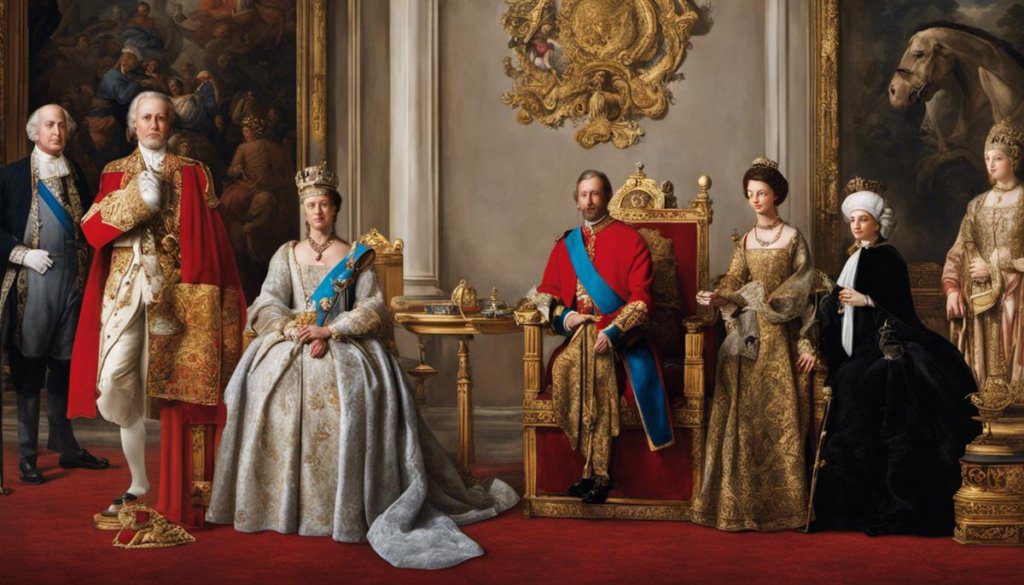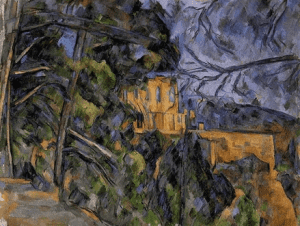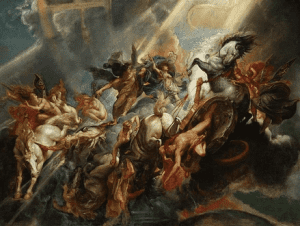As we explore the fascinating world of art in royal collections, immerse yourself in a world of grandeur and elegance. Explore the history of the world while charting the development of art as it was shaped and curated by regal whims and tastes. The transformation of royal collections, their impact on art and artists, the illustrious canvases housed within the opulent grandeur of palaces, and the ways they are shared with the world are all revealed in this vivid narrative.
The Evolving of Royal Collecting
The Origination of Royal Collecting
The tradition of collecting art among royalty is thought to have originated in the Middle Ages with royal and noble classes hoarding various forms of artistic creations. They initially focused on religious artefacts such as reliquaries, illuminated manuscripts, and altarpieces, often made of precious metals and gemstones. These items were acquired not just for their aesthetic value but also as a sign of piety and a means to acquire prestige.
The Renaissance and Royal Collecting
As we moved into the Renaissance era, including the 15th – 17th centuries, the scope of royal collecting began to expand. There was an increased emphasis on portraiture, as monarchs began to recognise the power of art as a tool for propaganda. Owning a portrait by a renowned artist was not just about displaying personal wealth but also an assertion of power and prestige. Items from other cultures also started making their way into royal collections during this era due to increased exploration and conquest, leading to collections becoming a representation of the breadth of a monarch’s dominion.
The Enlightenment and Royal Collecting
The Enlightenment, between the late 17th and 18th centuries, heralded new changes in royal collecting. Here, the focus shifted towards more intellectual pursuits, and collections often included scientific instruments, antiquities, and natural curiosities. Metalwork, including both silver and gold, engravings and prints also found their way into royal collections. The Enlightenment era also saw the beginnings of royal collections becoming more accessible to the public, fostering a broader cultural appreciation of art. This often took the form of a ‘cabinet of curiosities’ or a ‘Kunstkammer’ which displayed a wide variety of objects to intrigue and educate visitors.
The Modern Era and Royal Collecting
The 19th and 20th centuries saw further evolution in royal collecting, with a greater interest in contemporary art. From the Impressionists to modernist movements, royalty started to acquire pieces that were reflective of their time. This move towards contemporary art has continued into the 21st century, with the current generation of royals becoming patrons of current artists and movements, continuing to evolve and shape the face of royal collections.
Continuity in Royal Collecting
Despite these changes over the centuries, it’s noteworthy that one thing has remained constant: the intrinsic value attached to these collections. Even as tastes have evolved and different types of items have come into favour, these collections have always served as a demonstration of the monarch’s wealth, power, and prestige.
An Introduction to Royal Collections
The royal art collections of today serve more than just an aesthetic purpose—they tell the vivid stories of past eras, encapsulating historical values, belief systems, and societal narratives. These collections reflect the diverse tastes, patronage, and art appreciation of successive generations of royals, making them a living history of artistic evolution over time.

Royalty’s Influence on Art
The Role of Royal Patronage in Artistic Evolution
Royal patronage has played an instrumental role in the evolution and shaping of various artistic trends. Throughout history, wealth and influence have allowed monarchs to commission an array of art forms, from masterfully crafted portraits and sculptures to grand architectural endeavours. Thus the royal families have not only sustained the livelihoods of numerous artists, but they have also strategically used art to influence and shape the monarchy’s public persona.
Art Trends Guided by Royal Tastes
The tastes and preferences of royals have markedly impacted art trends throughout history. Monarchs typically commission art that mirrors their ideals, beliefs, and values, steering the direction of cultural expression.
Artwork Examples in Royal Collections
Royal collections have been instrumental in preserving significant pieces of art. For instance, the Royal Collection Trust in the UK houses one of the world’s most extensive art collections, featuring over a million objects accumulated by British monarchs over the past 500 years. This collection boasts a range of masterpieces, from expressive portraits by Hans Holbein the Younger to Italian Renaissance drawings by Leonardo da Vinci.
Another example is the Prado Museum in Madrid, which was originally established to showcase the Spanish Royal Collection. It holds masterpieces by Spanish artists like Velázquez and Goya who were court painters and whose works were greatly influenced by the interests and preferences of the royals they served.
The Enduring Impact of Royalty on Art
In the current era, the sway of royal patronage over artistic endeavours remains intact, albeit with an evolved complexion. Contemporary royal personalities employ art as a tool for fostering cultural diplomacy, bolstering national identity, and championing the pursuits of modern artists. To illustrate, Her Majesty Queen Elizabeth II frequently extends loans of artefacts from the Royal Collection to museums, aiding the public’s appreciation and understanding of art. Furthermore, The Prince of Wales, known for his personal affinity for watercolour painting, heads the Prince’s Foundation, an organisation dedicated to the preservation of heritage crafts and architecture, hence underscoring the enduring tradition of royal patronage in the arts.

Famous Artworks in Royal Collections
The British Monarchy’s Royal Collection
The British Monarchy presides over one of the most impressive and expansive compendiums of art in any royal collection globally. Amassing over a million artefacts, the Royal Collection encompasses an array of paintings, sketches, sculptures, and other art treasures. A prime exemplar of which includes “The Annunciation, with Saint Emidius” by Carlo Crivelli. This celebrated artwork, created in 1486, is esteemed for Crivelli’s exceptional depiction of light and depth, infusing the piece with a surreal degree of realism. The historic importance of the painting is further amplified due to it entering the Royal Collection during Charles II’s reign, post the fall of Oliver Cromwell’s Commonwealth, making it a symbol of the monarchy’s restoration.
Hermitage Museum
The Hermitage Museum of Russia, founded by Catherine the Great, showcases one of the largest art collections worldwide, boasting over three million works encompassing a timeline from the stone age to the early 21st century. A highlight of this royal collection includes Rembrandt’s “The Return of the Prodigal Son”. The depth of emotion displayed in this artwork and the striking depiction of forgiveness and love has made this piece an iconic image in art history. It became part of the Russian royal collection in 1766 when Catherine the Great acquired it, further embellishing her reputation as a serious art collector.
Spanish Royal Collection
Notable for its extensive array of works by Velázquez and Goya, the Spanish Royal Collection is an expansive repository of European art. It is preserved in Madrid’s Prado Museum, originally intended as a natural science museum under King Charles III. Francisco de Goya’s “The Third of May 1808” depicts the executions of Spanish citizens who rose against Napoleon’s occupying forces. Its addition into the royal collection, while initially commissioned by the Spanish monarchy, remains a cheeky testament to Goya’s critical interpretations of the monarchy’s actions during the Peninsular war.
Versailles Collection
In France, the Palace of Versailles harbours a vast collection of artwork, a major part of which comprises portraits and historical scenes. This collection includes the famous “The Coronation of Napoleon” by Jacques-Louis David, commissioned by Napoleon himself. This painting is significant because it not only illustrates Napoleon crowning himself as Emperor, but also captures his slightly hunched figure standing taller than all at the ceremony – a visual propaganda used to depict his power and jurisdiction.
Art in the Vatican
The Vatican, albeit not a traditional monarchy, houses an impressive collection of art that consists of many royal donations and commissions acquired over centuries. Among these, “The Sistine Chapel Ceiling”, painted by Michelangelo, holds a prominent position. Exhibiting a range of frescoes, it masterfully relates the Biblical narrative of Genesis in full flourish of High Renaissance art. Painted on the benevolent order of Pope Julius II, this marvellous ceiling has impressed art enthusiasts worldwide, marking its position as one of the most frequently visited masterpieces in the present day.

Access and Display of Royal Art Collection
The Royal Collection Trust
Caring for and curating one of the world’s most extensive and critical art collections, The Royal Collection Trust stands as a testament to the appreciation for art within the British royal family. Queen Elizabeth II took the initiative to establish this trust in the year 1987. Today, the collection has expanded to house an exhaustive variety of over a million art works that include paintings, sculptures, tapestries and ceramics, alongside other decorative art forms. Furthermore, the Trust also preserves a vast array of historical photographs and documents.
Public Access to Royal Collections
The Royal Collection is not held in a single location but is scattered across 13 royal palaces and former residences around the UK, including Buckingham Palace, Windsor Castle, and Hampton Court Palace. Many of these sites are open to the public, allowing them to view the collection in the context it was intended for, in the royal residences themselves.
The Historical Stewardship of the Royal Collection
Historically, the royal family has been a patron of the arts, collecting works from around the world for centuries. Since these works were typically obtained for private enjoyment or diplomatic gifting, public accessibility was not originally a priority. That changed, however, in the 19th century with Queen Victoria, who opened the South Kensington Museum, now known as the Victoria and Albert Museum, featuring items from the Royal Collection. This began a tradition of public access that continues today.
Policy on Lending Artworks
Under the oversight of the Royal Collection Trust, many pieces from the royal collection are made available for loan to reputable institutions both within the UK and internationally. This helps to further the reach and impact of the collection, allowing more people to have access to these significant works. The decision to lend these pieces is made on a case-by-case basis, considering factors such as the relevance of the work to the proposed exhibition, the security and environmental conditions of the borrowing institution, and the condition of the work itself.
Online Access
In addition to physical access, the Royal Collection Trust has made significant efforts in recent years to digitise the collection and make it available online. This ongoing project means that anyone around the world can explore the collection, learning about the artworks and their history from the comfort of their own home.
Educational Purpose
Apart from displaying the art collection, the Royal Collection Trust also places a significant emphasis on education. By offering learning programmes and educational visits, the Trust aims to inspire a wider appreciation and understanding of the works within the collection. It provides an opportunity to learn not only about the specific artworks but also about the wider historical and cultural context in which they were created.
Special Exhibitions
In addition to the permanent displays in the palaces, the Royal Collection Trust also organises special exhibitions. These exhibits focus on specific aspects of the Collection, allowing a deeper exploration of particular themes, periods or artists. These exhibitions are typically held at The Queen’s Gallery at Buckingham Palace and The Queen’s Gallery at the Palace of Holyroodhouse and often include works that are not usually on public display.

Indeed, royal art collections stand not only as a testimony to art’s ever-changing landscape shaped by royal patronage but also as a dynamic web linking us to our collective cultural history. The accessibility and display of these collections bridge the chasm between the royalty and the public, shedding light on artistic heritage and fostering a sense of shared appreciation for cultural aesthetics. Thus, as we admire the awe-inspiring masterpieces, we simultaneously unearth layers of historical evolution, royal tastes, and the interconnected complexity of societal contexts.
Recommend0 recommendationsPublished in Art History








Responses